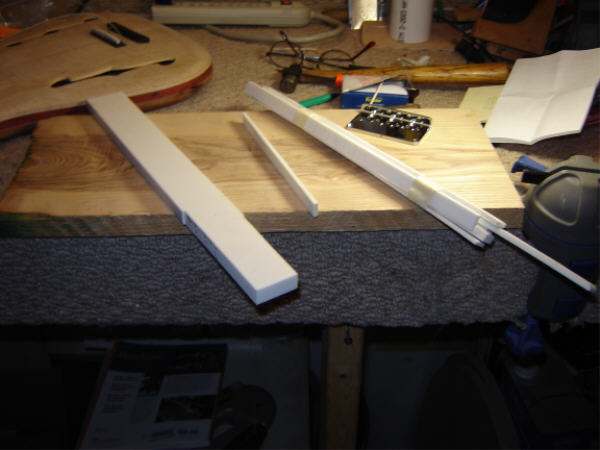Here's some info I received from a professional guy who works with Corian, and BTW Martin Guitar uses Corian on some of their guitars.
"Cris, Corian is acrylic "ballasted" with marble
powder, although Corain is expensive at $350-$700 a
sheet it would be more expensive if it was solid
acrylic. The marble content accounts for the WEIGHT
of the material, it weighs just about as much as solid
stone.
Having said that, it works well with normal carbide
tooling. YES it's tougher to work than most wood.
Having said that he material is CONSISTENT which makes
it easier to work in some ways than wood, there's no
grain.
The typical Corian workshop uses a large radial arm
saw to cut down Corian sheets, then a normal 10" table
saw to cut it into strips. Individual Corian
fabricators are usually equipped with a 10" chop saw,
a 4 x 24" belt sander and an armada of 3 horsepower
routers. The primary router bits used are 1/2" single
flute, 1/2" double flute and 1" flush cutter. These
combined with various straight edges and jigs enable
the Corian fabricator to "carve" out a variety of
profiles. Edge detail is accomplished with smaller
routers like the Porter-Cable 690 series using 1/4"
roundover, 3/8" roundover or several different ogees.
That's for kitchen countertop fabrication...
For your purposes if you have a good bandsaw blade...
SAVE it! Corian will eat up your bandsaw blade twice
as fast as hardwood by my estimate. Having said that
it might not be too bad for the small amount of
material you need to cut. We cut down up to a hundred
10' sheets in a week, our notmal tool rotation is to
re-sharpen blades once a week.
Abrasives work quite well, coarse abrasives leave a
surprisingly smooth finish. Use a reciprocating
spindle sander if you've got one. For a recent
project we had to face a piece of millwork with 1/4"
Corian, instead of re-ordering 1/4" goods (1/2" is the
norm) the millworking contractor milled 1/2" material
down to 1/4" in their panel sander. an abrasive
planer does the same job."
CrowDuck
|


 I like the sheeps horn idea though. Are there other alternatives such as, don't know, old marble tiles or other hard stuff that i would be able to use for this ?
I like the sheeps horn idea though. Are there other alternatives such as, don't know, old marble tiles or other hard stuff that i would be able to use for this ?


